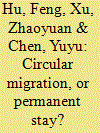| Srl | Item |
| 1 |
ID:
103909


|
|
|
|
|
| Publication |
2011.
|
| Summary/Abstract |
Although there is a rich literature on internal temporary migration in China, few existing studies deal with the permanent migration decision of China's rural labor. This paper will fill this gap and deal with the permanent migration choice made by rural migrants with the China General Social Survey (CGSS) data. Our results show that compared with their circular counterparts, permanent migrants tend to stay within the home provinces and are more likely to have stable jobs and earn high incomes and thus are more adapted to urban lives. We also find that more educated and more experienced migrants tend to be permanent urban residents, while the relationship of age and the probability of permanent migration is inverse U-shaped. Due to the restrictions of the current hukou system and the lack of rural land rental market, those people with more children and more land at home are more likely to migrate circularly rather than permanently.
|
|
|
|
|
|
|
|
|
|
|
|
|
|
|
|
| 2 |
ID:
178489


|
|
|
|
|
| Summary/Abstract |
This study uses data covering 3,914 farm households, collected from Henan province in China, to investigate the links between the price of agricultural mechanization services and farmers' exit from land operation. The results indicate that the increasing price of agricultural mechanization services leads to farmers leaving land operation, especially when the high sunk costs and the long-term breakeven period of self-owned machinery are considered. This effect is intensified by the rapid rural–urban migration in China. Further analysis reveals that the surge in service prices reduced land renting-in and encouraged non-grain production. Our analysis suggests that the agricultural mechanization service market in China tends to work against the survival of smallholder farmers. However, the price of agricultural mechanization services is conducive to eliminating less-productive farmers and cultivating new agricultural operators.
|
|
|
|
|
|
|
|
|
|
|
|
|
|
|
|
| 3 |
ID:
110502


|
|
|
|
|
| Publication |
2011.
|
| Summary/Abstract |
Many recent studies claim that China has reached a Lewisian 'turning point' in economic development, signalled by rising wages in urban areas and the exhaustion of rural surplus labour. In this paper we show that despite some evidence of rising nominal urban unskilled wages between 2000 and 2009, there is little in the data to suggest that this wage increase has been caused by unskilled labour shortages. China still has abundant under-employed workers with very low income in the rural sector. We argue that China's unique institutional and policy-induced barriers to migration have both prevented many rural workers from migrating to cities and also reduced the migrants' length of stay. We project that under alternative institutional settings, the migrant stock could easily be doubled from the current 150 million to 300 million by increasing either the average length of migrant stay, or the migrant inflow, or both.
|
|
|
|
|
|
|
|
|
|
|
|
|
|
|
|
| 4 |
ID:
110506


|
|
|
|
|
| Publication |
2011.
|
| Summary/Abstract |
This paper assesses the applicability of two alternative theories in understanding labor market developments in China: the classical view featuring a Lewis turning point in wage growth versus a neoclassical framework emphasizing rational choices of individuals and equilibrating forces of the market. Empirical evidence based on multiple data sources fails to validate the arrival of the Lewis turning point in China, showing continuous and coordinated wage growth across rural and urban sectors instead. Consistent with the neoclassical view, we find that rural workers expanded off-farm work when mobility restrictions were lifted, interprovincial migration responded to expected earnings and local employment conditions, and returns to education converged gradually to the international standard. These findings suggest major progresses in the integration of labor markets in China.
|
|
|
|
|
|
|
|
|
|
|
|
|
|
|
|